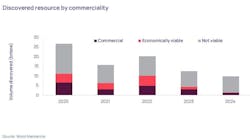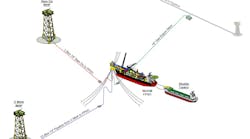Offshore staff
EDINBURGH, UK – The number of upstream projects sanctioned for a final investment decision (FID) in 2017 was more than double the previous year’s figure, according to Wood Mackenzie.
This year the analyst foresees a similar total of around 30 FIDs thanks to continued cost reduction efforts. The main focus, it adds, has been on reducing project footprints through fewer wells, smaller facilities, and greater use of subsea tiebacks and existing infrastructure.
As a result, last year’s new programs were on the small side, with average capex to develop ‘major’ projects (commercial reserves more than 50 MMboe) down to $2.7 billion, the lowest in a decade. This compares with average capex for projects sanctioned over the past decade of $5.5 billion.
“We are seeing significantly smaller projects, alongside a greater appetite for brownfield and expansion projects, and more subsea tiebacks,” said Jessica Brewer, a principal analyst at Wood Mackenzie.
“Brownfield developments are popular in the current capital-constrained environment, with less spend and execution risk than a greenfield project, and a faster route to first production. Both investors and operators want to see faster cycle times and quicker returns on upstream projects.
“We should continue to see operators favouring a ‘leaner and meaner’ path in 2018. At the beginning of the year we selected 30 projects we thought were most likely to make FID, and they follow many of the trends we saw emerge in 2017. Average capex continues to fall – averaging only $2.2 billion – while capex/boe is now only $4.9/boe, versus $11.3/boe back in 2011.”
Wood Mackenzie also foresees average breakeven costs dipping by 15% to $44/boe, with the most competitive projects being in shallow water offshore Norway, the UK, and Mexico. Three will also be some big gas expansion projects offshore Norway and Iran.
By the end of March 2018, six projects had already been sanctioned, including theLingshui development in the South China Sea, the first Chinese wholly-owned and -operated deepwater gas project.
However, Angus Rodger, research director at Wood Mackenzie warned: “We cannot rely on smaller projects forever, and when we look at LNG in particular, we see a lot of big projects on the horizon.”
The FID story could shift again in 2019, with multi-billion boe developments such asMozambique LNG and expansions in Qatar and Papua New Guinea all approaching FIDs.
“Can the industry apply the leaner lessons it has learnt through the downturn to these giant projects, or will we return to the boom and bust cost cycles of the past?” Rodger continued.
“Companies know they don’t want to be all rushing through that door at the same time and then see costs blow-out. So, it will be interesting to see if any of these LNG projects push for a late-2018 sanction, thereby locking-in lower costs and pipping the competition.”
04/05/2018


